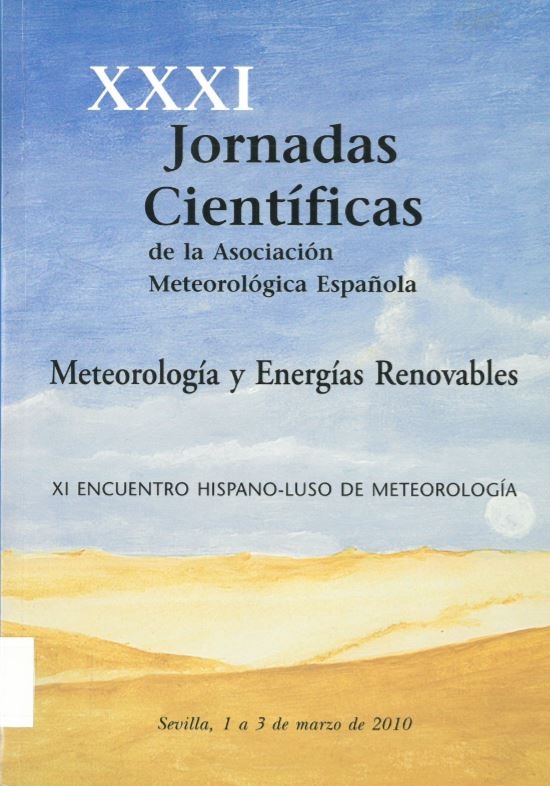COMPARISON BETWEEN ERA-Interim AND ERA-40 IN THE TROPICAL TROPOPAUSE REGION
Resumen
Reanalyses are fundamental tools in climate and variability studies. Their applicability runs through a wide range of fields: from the performance of empirical analyses to their use as initial condition or validation for general circulation models (GCM). In the last years the active role of the stratosphere in the climate system has been recognized, and the necessity to accurately study its climatological characteristics and variability has arisen. In the middle atmosphere reanalysis data are even more helpful due to the short number of observations. However, it is crucial to understand the limitations and biases in these databases, caused either by model errors, by the assimilation techniques or coming directly from observations.With the philosophy of evaluating the current understanding and uncertainties in the stratosphere, the SPARC Project (Stratospheric Processes And their Role on Climate) brought together eleven middle-atmosphere climatologies and made detailed comparisons (Randel et al., 2004a). One of the conclusions of this intercomparison was that the best database in reproducing tropical processes in the middle-atmosphere is ERA-40 reanalysis, the last one by ECMWF at that moment.
More recently a new reanalysis, named ERAInterim, has been developed at the ECMWF (Simmons et al., 2006). This reanalysis presents several improvements in key aspects affecting the stratosphere. A brief description of these advances is given in section 2.
Citas
Birner, T. and F. Collins (2009): “Residual circulation and tropopause structure”, J. Atmos. Sci., (submitted). Bohem, M. T. and S. Lee (2003): “The implications of tropical Rossby waves for tropical tropopause cirrus formation and for the equatorial upwelling of the Brewer-Dobson circulation”, J. Atmos. Sci., 60, 247-261. Butchart, N. and 11 co-authors (2006): “Simulations of anthropogenic change in the strength of the Brewer-Dobson circulation”, Clim. Dyn., 27, 727-741, doi: 10.1007/s00382-006-0162-4. Calvo, N. and R. R. Garcia (2009): “Wave forcing of the tropical upwelling in the lower stratosphere under increasing concentrations of greenhouse gasses”, J. Atmos. Sci., 66, 3184-3196, doi: 10.1175/2009JAS3082.1. Fueglistaler, S. and 5 co-authors (2009a): “Tropical tropopause layer”, Rev. Geophys., 47, RG1004, doi: 10.1029/2008RG000267. Fueglistaler, S. and 6 co-authors (2009b): “The diabatic heat budget of the upper troposphere and lower/mid stratospohere in ECMWF reanalyses”, Quart. J. R. Meteorol. Soc., 135, 21-37, doi: 10.1002/qj.361. Kerr-Munslow, A. M. and W. A. Norton (2006): “Tropical wave driving of the annual cycle in tropical tropopause temperatures. Part I: ECMWF analyses”, J. Atmos. Sc., 63, 1410-1419. Palazzi, E. and 8 co-authors (2009): “Diagnostics of the Tropical Tropopause Layer from in-situ observations and CCM data”, Atmos. Chem. Phys., 9, 11659-11698. Pan, L. L., J. C. Wei, D. E. Kinnison, R. R. Garcia, D. J. Wuebbles, and G. P. Brasseur (2007): “A set of diagnostics for evaluating chemistryclimate models in the extratropical tropopause region”, J. Geophys. Res., 112, D09316, doi: 10.1029/2006JD007792. Plumb, R. A. (2002): “Stratospheric transport”, J. Meteorol. Soc. Japan, 80, 793-809, doi: 10.2151/jmsj.80.793. Randel, W. J. and 17 co-authors (2004a): “The SPARC intercomparison of middle-atmosphere climatologies”, J. Climate, 17, 986-1003. Randel, W. J., F. Wu, K. Oltmans, K. Rosenlof, and G. E. Nedoluha (2004b): “Interannual changes of stratospheric water vapor and correlations with tropical tropopause temperatures”, J. Atmos. Sci., 61, 2133-2148.
Randel, W. J., F. Wu, H. Vömel, G. E. Nedoluha, and P. Forster (2006): “Decreases in stratospheric water vapor after 2001: links to changes in the tropical tropopause and the Brewer-Dobson circulation”, J. Geophys. Res., 111, D12312, doi: 10.1029/2005JD006744. Randel, W. J., M. Park, F. Wu, N. and Livesey (2007): “A large annual cycle in ozone above the tropical tropopause linked to the Brewer-Dobson circulation”, J. Atmos. Sci., 64, 4479-4488. Randel, W., R. Garcia, and F. Wu (2008): “Dynamical balances and tropical stratospheric upwelling”, J. Atmos. Sci., 65, 3584-3595, doi: 10.1175/2008JAS2756.1 Santer, B. D. and 11 co-authors (2003): “Behavior of tropopause height and atmospheric temperature in models, reanalyses, and observations: decadal changes”, J. Geophys. Res., 108, D1, 4002, doi: 10.1029/2002JD002258. Semeniuk, K. and T. G. Shepherd (2001): “Mechanisms for tropical upwelling in the stratosphere”, J. Atmos. Sci., 58, 3097-3115. Simmons, A., S. Uppala, D. Dee, and S. Kobayashi (2006): “ERA-Interim: new ECMWF reanalysis products from 1989 onwards”, ECMWF Newsletter, 110, 25-35. Uppala, S. and 45 coauthors (2005): “The ERA-40 Re-analysis”, J. R. Meteorol. Soc., 131, 612, 29613012 Uppala S., D. Dee, S. Kobayashi, P. Berrisford, and A. Simmons (2008): “Towards a climate data assimilation system: status update of ERA-Interim”, ECMWF Newsletter, 115, 12-18.

